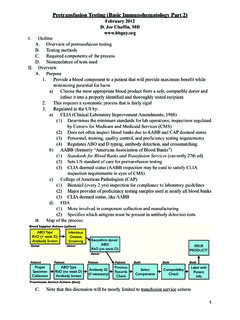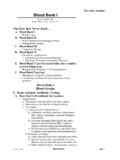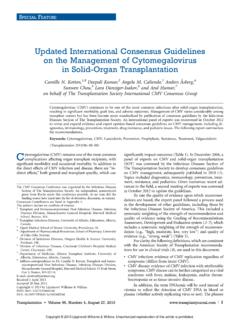Transcription of 2012 11 TX RXNs - Blood Bank Guy
1 Transfusion Reactions D. Joe Chaffin, MD. November/December 2012 Blood Bank Guy Podcast A. Scope of the problem 1. Transfusions still harm, despite great reductions in transfusion-transmitted diseases Figure 1: FDA Transfusion Fatalities FY 2007-2011. (Source: ). B. Suspected reaction workup 1. When? a. Indicated when possible reaction is suspected by a combination of signs/symptoms b. Just a few: 1) Inflammatory: a) Fever/chills b) Skin changes c) Pain at infusion site 2) Circulatory: a) Blood pressure changes b) Shock c) Hemoglobinemia/uria 3) Pulmonary: a) Dyspnea, orthopnea, wheezing b) Full respiratory failure 4) Coagulation: a) Unexplained increase in bleeding b) DIC. 5) Psychological: a) Sense of unease or impending doom ! 2. General philosophy (my opinions): a.
2 Opinion 1: Assume all suspected reactions are hemolytic, and work to disprove your assumption 1) A high index of suspicion is much better than low 2) You will be wrong in your assumption almost every time, but the one time that you are right will be life-saving! Page 1. Nov/Dec 2012 . b. Opinion 2: Anyone involved in a transfusion should be allowed to initiate a transfusion reaction workup 1) Nurses, perfusionists, and other transfusing staff should be empowered to contact the Blood bank directly if suspicious findings occur during transfusion 2) This is from hard experience, with suspected reactions being under-reported (including the worst acute HTR of my professional life). 3. STEP ONE: STOP THE TRANSFUSION! a. Don't disconnect the unit (though that will eventually happen); at least stop the incoming flow of Blood .
3 B. Main indicator of survival of an acute HTR: amount of incompatible Blood infused; as a result, the obvious thing to do if you are assuming hemolysis is to stop the transfusion c. Leave the line open with saline. Figure 2: Transfusion Reaction Workup 4. Necessary parts of workup (things everyone should do): a. Clerical check 1) Bedside paperwork and bag check to ensure right unit went to right patient 2) Blood bank paperwork and computer check to answer same question 3) Should include a basic inspection of the unit for discoloration or obvious issues a) Darkened color in unit: Suspicious for bacterial contamination b) Check for clots, aggregates, or anything out of the ordinary b. Visible hemoglobinemia check 1) Spin a post-transfusion EDTA sample and examine visually for a pink-red color change indicative of free hemoglobin in the plasma a) Best to use EDTA because you can then use the same sample for the tube DAT.
4 2) Compare to pretransfusion sample if abnormal. 3) Detects as little as to 5 ml of hemolysis occurring anywhere in the body 4) Most sensitive way to detect intravascular hemolysis; not specific, though a) Some causes of false-positive visible plasma hemoglobin: Poor phlebotomy technique (traumatic stick, drawing through IV line). Nonimmune hemolysis (infusion with NS, faulty Blood warmers, etc.). Autoimmune hemolysis G6PD deficiency and hemoglobinopathies b) Some causes of false-negative visible plasma hemoglobin: Delay in drawing sample (with functioning kidneys, hemoglobin may be cleared in several hours). Sample collected from IV line (dilution of Blood ). Transfusion Reactions Chaffin page 2. Nov/Dec 2012 . c. Direct antiglobulin (Coombs) test (DAT). 1) Demonstrates coating of RBCs with antibody and/or complement in-vivo (see figure 3 below).
5 2) Most commonly done with polyspecific method (IgG + C3d). 3) If positive, must compare to pretransfusion DAT (automatically done in most places). 4) Note that a positive DAT does not prove an acute hemolytic reaction a) Other causes include nonspecific positives in hospitalized patients (20%), autoantibodies, drugs, passive administration of other things like RhIG or IVIG. 5) Also note that a negative DAT does not disprove an acute hemolytic reaction a) If donor RBCs are completely destroyed by brisk hemolysis, DAT will be negative (especially seen with ABO incompatible transfused RBCs). b) Small amounts of residual donor RBCs (<10% of circulating RBCs) may give false negative tube DAT; gel DAT may help if strongly suspected Figure 3: Direct Antiglobulin Test (DAT).
6 Image credit: A Rad 2006. d. Repeat ABO/Rh testing 1) Another check for right patient, right Blood 2) Check both pre- and post-reaction specimens 5. Other things that may be done (but are not required as a part of every workup). a. Facilities must define triggers for when they would do additional testing b. Additional testing for suspected hemolysis: 1) Repeat antibody screen (on both pre- and post-transfusion samples); consider different enhancement (PEG, LISS, cold/warm incubation, etc) or platform 2) Repeat crossmatch with pre- and post samples a) If no serologic crossmatch was done ( , if computer crossmatch used), it should be done if there is suspicion on first-tier investigation b) Best done with tube technique including immediate spin and IAT phase readings +/- 37 C reading (gel does not necessarily detect ABO incompatibility).
7 3) Elution studies if DAT is positive to determine specificity of the antibody 4) Haptoglobin a) Haptoglobin binds to free hemoglobin molecules, facilitating their clearance from the circulation by monocytes and macrophages in the RE system This interaction prevents iron from escaping through the kidneys Also lessens any toxic effect of hemoglobin in the kidneys b) Levels decrease sharply in acute intravascular hemolysis (traditional belief; more current data suggests that it decreases in extravascular hemolysis as well). c) Long turnaround time and acute phase reaction make for limited usefulness in acute setting. If you must use, compare pre- and post levels. 5) Direct and indirect bilirubin Transfusion Reactions Chaffin page 3. Nov/Dec 2012 . a) Really more useful to confirm, not make diagnosis b) Both will rise quickly, peak in less than 10 hours, may be normal within 24.
8 Hours (if liver is OK). c) This is in contrast to traditional teaching that acute hemolysis does not elevate direct bilirubin 6) Lactate dehydrogenase (LDH). a) Another marker of hemolysis, as LDH is abundant in RBCs (especially LD2 and LD1 isoenzymes). b) Not specific for intravascular hemolysis (+/- in extravascular, too). 7) Urine hemoglobin a) Not as sensitive or as fast as hemoglobinemia for intravascular hemolysis b) Really only useful if testing for visible hemoglobin has been delayed or if there is doubt about a positive visible hemoglobin check c) Remember that hematuria does not equal hemoglobinuria! c. Additional testing for suspected septic reactions: 1) Not done routinely on all reaction workups by most facilities 2) Should be done if suggested by clinical data, for example: a) Temperature greater than 102 F.
9 B) Temperature increase greater than a specified amount (2 or 3 degrees F). c) Severe rigors d) Clinical septic shock-type findings (marked hypotension, gastrointestinal complaints, later findings of multi-organ failure, DIC, etc.). 2) Both patient and product must be evaluated a) Patient: Blood cultures (drawn as soon as possible from a different site than the infusion); aerobic and anaerobic Consider culture of all intravenous fluids running at the time of reaction if clinically suspicious of sepsis b) Product: Gram stain and culture of actual residual product in the bag (don't culture a segment unless there are absolutely no other options!). d. Additional testing for suspected respiratory reactions (see details in TRALI/TACO. sections): 1) Chest X-ray 2) BNP levels 3) ABG.
10 4) Donor testing for anti-HLA/HNA antibodies e. Additional testing for suspected severe allergic reactions: 1) Serum IgA levels (performed on pretransfusion sample!). 2) Consider serum anti-IgA detection if serum IgA is non-detectable C. Classification of reactions 1. Worldwide, there is a movement to standardize the definitions of transfusion reactions as well as to improve reporting 2. In the US, this movement is led by the CDC National Healthcare Safety Network (NHSN). and is known as Biovigilance (more specifically as hemovigilance ). 3. This lecture includes entities defined in the hemovigilance module (found at ). 4. Below is an approach to screening transfusion reactions based on the presence or absence of fever and the timing of the reaction (Acute = during or < 24 hrs after transfusion, Delayed = > 24 hrs after transfusion).




